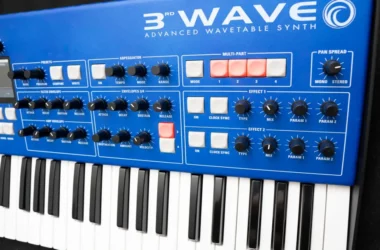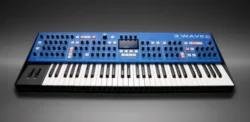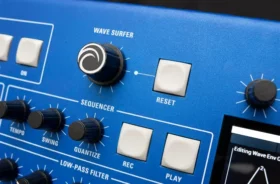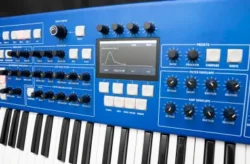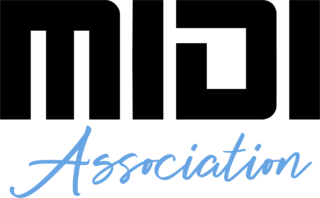Groove Synthesis 3rd Wave Synthesizer debuts at 2022 NAMM Show
Groove Synthesis, an electronic musical instrument startup founded by music industry veterans from Avid/Digidesign and Sequential, has officially introduced its first synthesizer, the 3rd Wave Advanced Wavetable Synth, at the 2022 NAMM Show today – being held June 3-5 in Anaheim, California.
The 3rd Wave is a 24-voice, 4-part multi-timbral wavetable synth, with 3 oscillators per voice, analog low-pass filters, a state-variable filter, 6-stage wave envelopes per oscillator, and an industry-first Wavemaker tool that allows users to create custom wavetables in a single step, through proprietary sample-to-wave technology.
Each of its three oscillators can generate a classic PPG-era wavetable, a modern high-resolution wavetable, or an analog-modeled waveform.
Though the 3rd Wave has roots in the classic digital wavetable synths of the past, it takes the concept into the 21st century with a lush, expansive sound that’s a product of its expanded wavetables and analog filters. It features a Dave Rossum-designed 2140 analog low-pass filter with variable saturation and resonance compensation, and a second, SEM-style state-variable filter (low-pass, high-pass, notch, and band-pass) for additional tone-sculpting. Both can be used in series for harmonically complex textures.
In addition to its factory wavetables (32 classic PPG-lineage waves plus 48 high-resolution custom waves), users can create custom wavetables of their own using the built-in Wavemaker tool and fill any of the 64 available high-resolution slots. The Wavemaker tool’s sample-to-wavetable capability allows users to connect an audio source to the synthesizer’s rear-panel audio input and generate a 64-wave wavetable at the touch of a button. Alternatively, users can import a 96kHZ wav file into the synth using USB.
With 24-voices, the 3rd Wave can handle note-intensive performances, layer up to 4 parts or create 4 independent split zones — each with a completely different sound, sequence, and dual effect. Each part has independent panning, volume, effects, and a dedicated stereo physical output.
Each of its 3 wavetable oscillators per part/voice has its own 6-stage, loopable wave envelope, which can create complex, evolving soundscapes.
Its pattern-based sequencer can sequence notes, songs, and parameters. Because the synth is multi-timbral, each of its 4 parts/layers has its own sequencer track. Sequences can be up to 24 patterns of up to 32 measures in length. Users can perform in real-time on the keyboard while a sequence or song plays. Users can also perform looped overdubbing of notes or parameter changes to build complex patterns interactively.
Other features include two digital effects per part, four ADSR envelopes (filter, amp, and two auxiliary) per part, four LFOs per part, and a 28-slot mod matrix per part. The synth is housed in a robust, all-metal chassis with a premium 5-octave, semi-weighted Fatar keyboard.
The 3rd Wave is slated for release in August of 2022, with an introductory price of $3795
Find out more info from the Groove Synthesis website.
